Expert travel storyteller Jordan Adkins, founder of InspiredByMaps.com, brings a decade of adventures across 101 countries and 450+ UNESCO sites into rich, off-the-beaten-path narratives, melding ecological expertise with genuine, seasoned travel insights. His full bio can be found here.
The Netherlands is one of the most engrossing travel destinations in the world, an intertwined mess of historical and contemporary excitement from Amsterdam’s history-soaked canals and Rotterdam’s urban jungle to the storybook-esque De Haar Castle and Keukenhof’s charming gardens.
There’s so much to see here but exploring the Netherlands’ most iconic landmarks is a perfect place to start …
There are beautiful cities, architectural landmarks, touching tales, small towns, stately homes, parks, farms, art and design, exhibitions and lots of customs and rituals. As you would expect in a nation with a long and storied history.
It is possible to forget, in the middle of all this, that this Western European country also has some beautiful scenery with two wind-swept coastlines and more than a few colorful fields.
In the Netherlands there’s just so much to visit; you might spend a lifetime enjoying its wealth and only just begin to scratch the surface. That’s why we created this cheat sheet to support you on your journeys.

But first – what is a landmark?
A landmark is a distinctive natural or artificial attribute that usually stands out from its surroundings and has become an emblem of local or national character. A landmark is helpful for urban visitors to travel-both in terms of being a tangible waypoint and in trying to assist you coordinate your itinerary.
Getting off the beaten track is all well and good, but at the end of the day, there are some places you just need to see when you visit a country. Immediately recognizable places that you couldn’t miss if you tried – like the Royal Palace of Stockholm or Victoria Harbour in Hong Kong.
And the Netherlands has more than just its fair share …
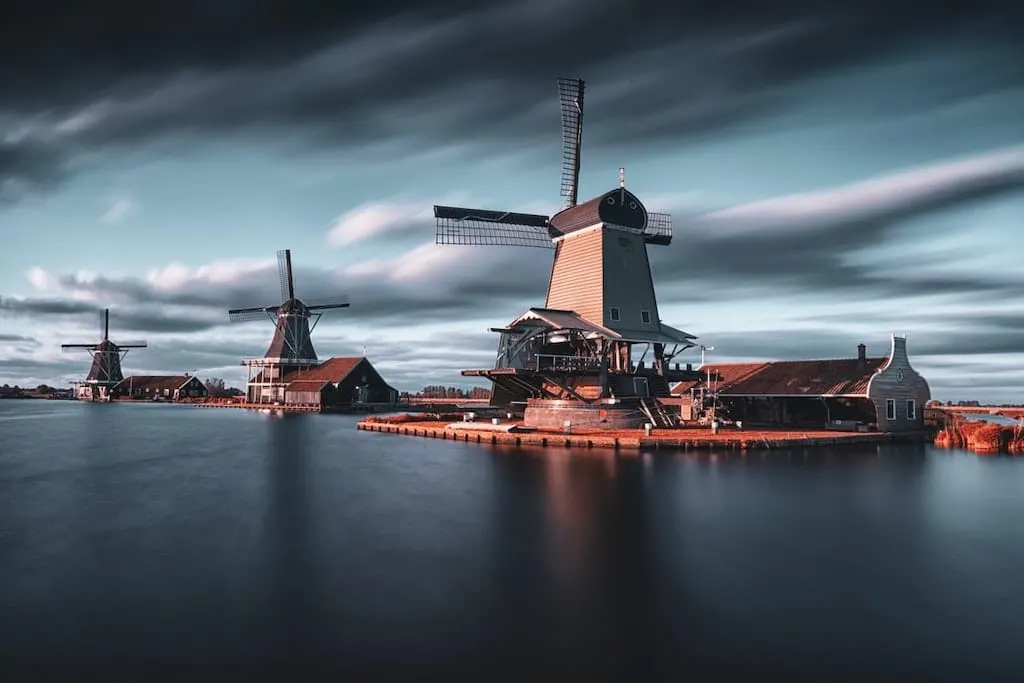
When approaching a trip to the land of clogs and millions of bicycles, you will want to tick off as many famous Dutch landmarks as you can – and the best way is to do that is often by renting a car, taking a tour, or using the Eurail Pass to get around.
There is a lot to explore in the Netherlands — and no list of famous Dutch landmarks can ever be exhaustive. But, we’ve tried to get the best bits by calling out to our favorite travel bloggers and asking them to give us tales and helpful tips about their best-loved ones.
This way, you have an appropriate frame of reference to motivate your journeys to the Netherlands, from which you can select a few landmarks that you truly can not miss … Or shoehorn as many of them as feasible on a single trip.
If you plan your Dutch trip right — and you’ve got enough time — you could just hit them all. This is a small country after all. And discover a great deal more of your own highlights of the Netherlands while you’re at it!
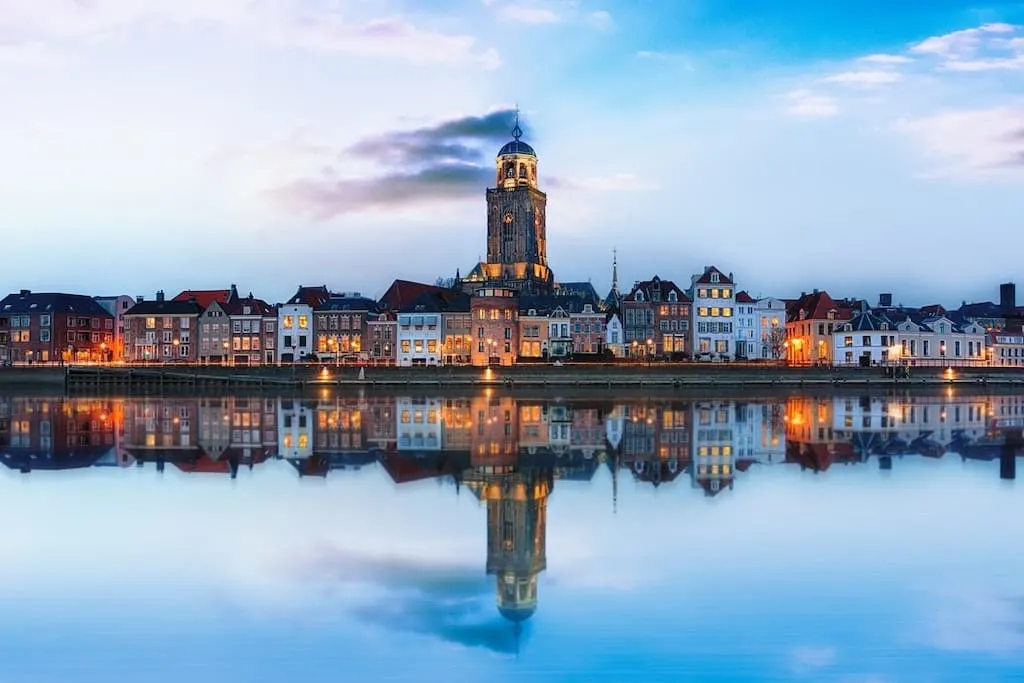
25 Famous Landmarks Of The Netherlands To Plan Your Travels Around! 🇳🇱
Page Contents
- 25 Famous Landmarks Of The Netherlands To Plan Your Travels Around! 🇳🇱
- Binnenhof
- Castle De Haar
- Circuit Zandvoort
- Cube Houses
- De Gooyer
- Deltawerken
- Dom Tower
- Efteling
- Erasmusbrug
- Evoluon
- Gouda Cheese Market
- Keukenhof
- Kinderdijk
- Kurhaus of Scheveningen
- Madurodam
- Rietveld Schröder House
- Stedelijk Museum Amsterdam
- Texel Lighthouse
- The 30-mile Beach Between Scheveningen and Zandvoort
- The Canals Of Amsterdam
- The Gingerbread Houses on Damrak
- Vaalserberg
- Van Gogh Museum
- Van Nelle Factory
- Windmill De Adriaan
Binnenhof
The Binnenhof is one of the best places to see on a day trip to The Hague (known as Den Haag), which is the administrative capital of the Netherlands. Within the Binnenhof, you’ll find the Dutch Parliament in an impressive castle turned government complex, which reflects all different periods throughout Dutch history. The Binnenhof has been used for governance in some form for the last 800 years, which makes it the oldest continually Parliament building in the world.
The Gothic castle was historically the home of the counts of Holland, although it became the main meeting space for the Dutch Republic before becoming the meeting point for Dutch Parliament.
The Hague is mostly known for the Knight’s Hall, which dates back to 1248, which can be seen after you enter the inner courtyard of the Binnenhof through the picturesque gates. The best viewpoint is from the other side of the Hofvijver, a pond that has long bordered the former castle. Be sure to try to find the small tower, which is the office of the Dutch Prime Minister.
If you plan ahead for your visit to the Hague, be sure to book a tour in advance to see the interior of the Binnenhof, although it should be noted that certain locations are off-limits due to security restrictions. Even if you cannot go inside, at least take a stroll through the Binnenhof and make a loop around before exploring the rest of The Hague. The Binnenhof is right in the centre of The Hague about 15 minutes on foot from The Hague Central Station with clear signage from the station.
Explored by Karen from Wanderlustingk
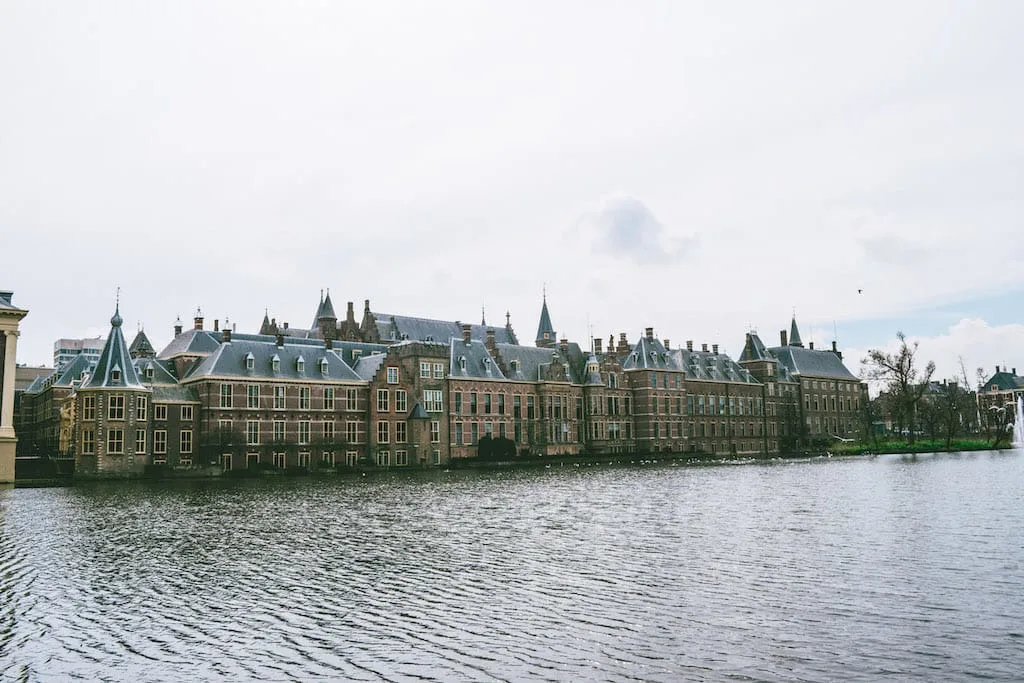
Castle De Haar
The beautiful Castle De Haar is one of the best places to visit in the Netherlands. This stunning castle in the medieval style is the largest one in the country. It is beautifully decorated with historical furnishings, taking you back to the old days.
De Haar Castle is located close to the city of Utrecht, making it a great day trip from either Amsterdam or Utrecht. You might also come along the name Ter Haar, Haarzuylens or Haarzuilens, all referring to the same castle. Beware though Castle Zuylen is actually another castle, not far from De Haar.
With two hundred rooms, De Haar is the biggest castle in the Netherlands, even out winning the ones from the Dutch royal family. Today’s castle has been constructed only in the nineteenth century but in medieval style. It had fallen into ruins before, but the family managed to reconstruct it with some newly found family funds by marrying into the wealthy Van Rothschild family.
The baron and baroness of those days were quite the society couple. They were known for hosting big parties at Castle De Haar, entertaining the Dutch royal family and famous movie actors of that time.
The castle was used only in September, though, a tradition the family still entertains. Even though the castle was transferred to a castle foundation, the family holds the right to use the castle one month each year.
When visiting the castle, plan in enough time for both the castle and the castle grounds. It’s lovely to stroll around the castle gardens and forests. You should buy a separate ticket for the park, though. Entrance tickets are € 17 for the castle and € 6 for the park.
Explored by Maartje and Sebastiaan from The Orange Backpack
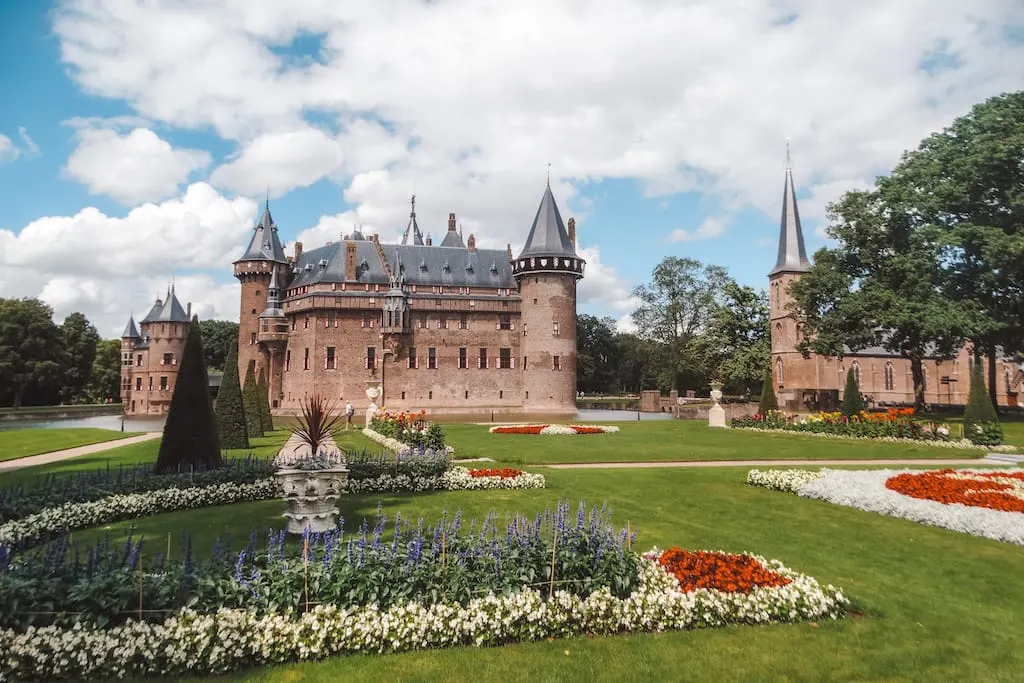
Circuit Zandvoort
A historic motorsport circuit in the sand dunes next to the North Sea, Circuit Zandvoort hosted the Dutch Grand Prix from 1948 to 1985. Multiple winners of the popular event include legendary drivers such as Jim Clark, Jackie Stewart, and Niki Lauda.
After a 36-year absence, the Dutch Grand Prix is set to make a highly-anticipated return to the Formula 1 calendar in 2021. The date for the race has not yet been announced, but it’s likely to be held in early May. Local interest in Formula 1 has risen in recent years thanks to the rise of Dutch driver Max Verstappen, and the event is expected to be a sellout.
Circuit Zandvoort also hosts smaller motorsport events throughout the year, including the Historic Zandvoort Grand Prix, G.T. World Challenge, and ADAC GT Masters. Driving and passenger experiences are also available at the circuit.
The circuit is located in the seaside town of Zandvoort, which can be reached by a direct train from Amsterdam in just 30 minutes and is also close to the city of Haarlem. Zandvoort aan Zee train station is near the center of the compact town, around 20 minutes’ walk from the entrance to the circuit.
A popular beach resort with local holidaymakers for almost 200 years, Zandvoort is known for its long sandy beach (including a well-known nudist beach 2km from the town), water sports, and beach bars. There’s a good selection of accommodation in the town, from campsites to apartments and resort hotels – though prices are expected to be sky high and availability very low for the Dutch Grand Prix in 2021!
Explored by Andrew of GPDestinations.com
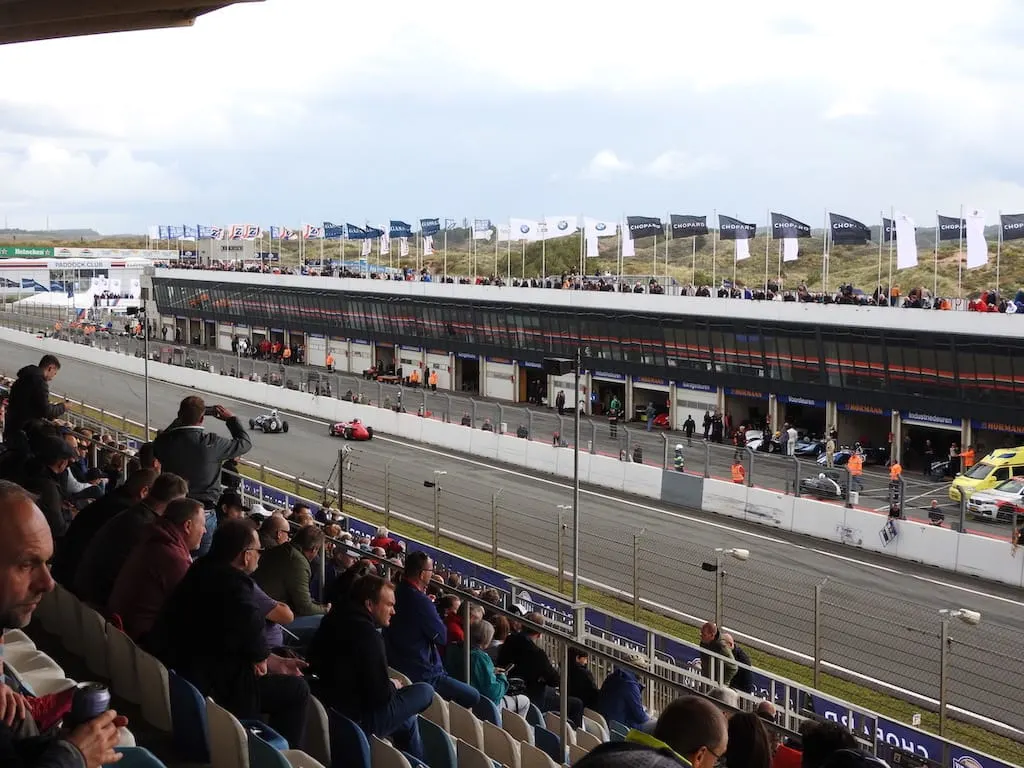
Cube Houses
Internationally renowned for its eclectic mix of striking landmarks and modern high-rise buildings, Rotterdam’s cityscape is real eye-candy for urban explorers. Most notably, the quirky, bright yellow Cube Houses (Kubuswoningen) are exemplary of the unique character of the innovative Rotterdam architecture.
Built by architect Piet Blom in 1984, these striking residential homes were based on his earlier Cube Houses in the city of Helmond. His innovative and playful design was a response to the unimaginative post-war architecture used in the rebuilding of the Netherlands.
Blom’s Cube Houses are wooden cube homes that are tilted and anchored in a concrete pillar on one corner. This allowed him to not only create an aesthetically pleasing residential neighborhood, but also to devise the idea of a village within a village.
With each home being part of a collective, Blom anticipated this would stimulate residents to connect and socialize with their neighbors. To further stimulate this, he left the large spaces between the pillars and angled walls empty, enabling casual meet-ups and interactions.
Drawn by the success of his first Cube Houses, Blom was invited to help rebuild part of Rotterdam, which was severely bombed during WWII. Recognizing the significance of this new housing project, he took his tried-and-tested design to Rotterdam to recreate a bigger and bolder version. This time, he painted them in canary yellow and doubled the number of houses.
Iconic of Rotterdam’s resurgence after the war and rise of the modern architecture the city is now famed for; the Rotterdam Cube Houses are a popular tourist attraction. Located in the upcoming Blaak neighborhood, it’s one of many interesting architectural gems in the area.
From the well-connected Blaak train station, the Cube Houses are only a 4-minute walk away. You’ll have the best views from the staircase in Kolk street. Looking up from there, the tops of the Cubes almost meet, creating an extremely photogenic star shape in the sky.
It is possible to go inside one of these peculiar houses. But be warned, the museum Kijk-Kobus (Viewing Cube) has been referred to as a tourist trap. Instead, take your time to wander around the neighborhood and make sure to keep your camera at hand.
Explored Zarina Rimbaud-Kadirbaks from Miss Travel Clogs
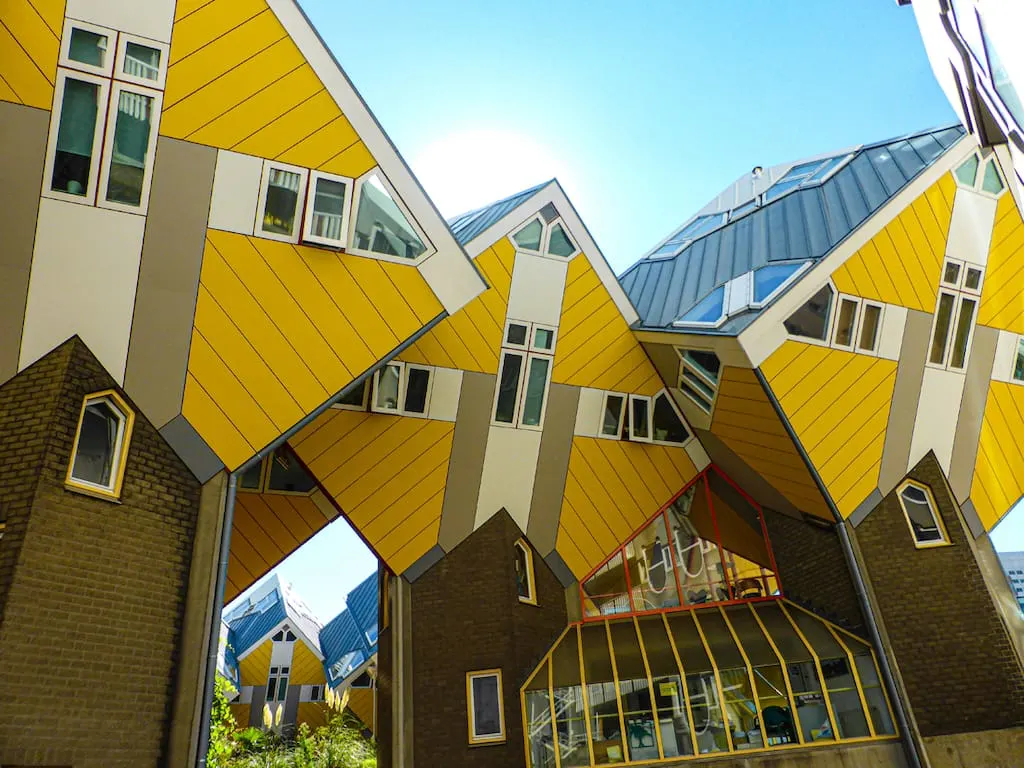
De Gooyer
De Gooyermthe only standing windmill in Amsterdam left (near the best area to stay in the city), is far more than an Instagram shot — it’s a national monument and a famous Dutch landmark.
The original Windmill De Gooyer was built in the 16th century in another location and served as a corn mill to Amsterdam. De Gooyer was then one of the many windmills on the bastions of the walls of the city.
About two centuries later, the brothers who owned it moved the mill to a nearby location where the wind’s power was needed. It remained on that spot up until the 19th-century when it moved to its current location.
However, De Gooyer eventually fell into decay, and Amsterdam’s municipality decided to buy and restore this piece of history.
Following the scarcity of means and electricity during World War II, the windmill continued to function as a corn mill to the city as before.
Currently, De Gooyer is not open to the public, which is unfortunate, but that doesn’t mean you can’t marvel at Netherland’s tallest wooden mill.
Brouwerij’ t I.J., a Dutch brewery–highly valued among locals, including me–opened its doors right next to the mill. So now you can sip a beer or two while admiring one of the most beautiful landmarks in the Netherlands.
De Gooyer is located between Funenkade and Zeeburgerstraat, and a bus leaving from Amsterdam Central Station can drop you almost at the door in less than 10 minutes.
For that, take the bus 22 toward Muiderpoorstation and get off at Oostenburgergracht stop. You’ll spot the windmill from there.
Explored by Bruna Venturinelli from Maps ‘N Bags
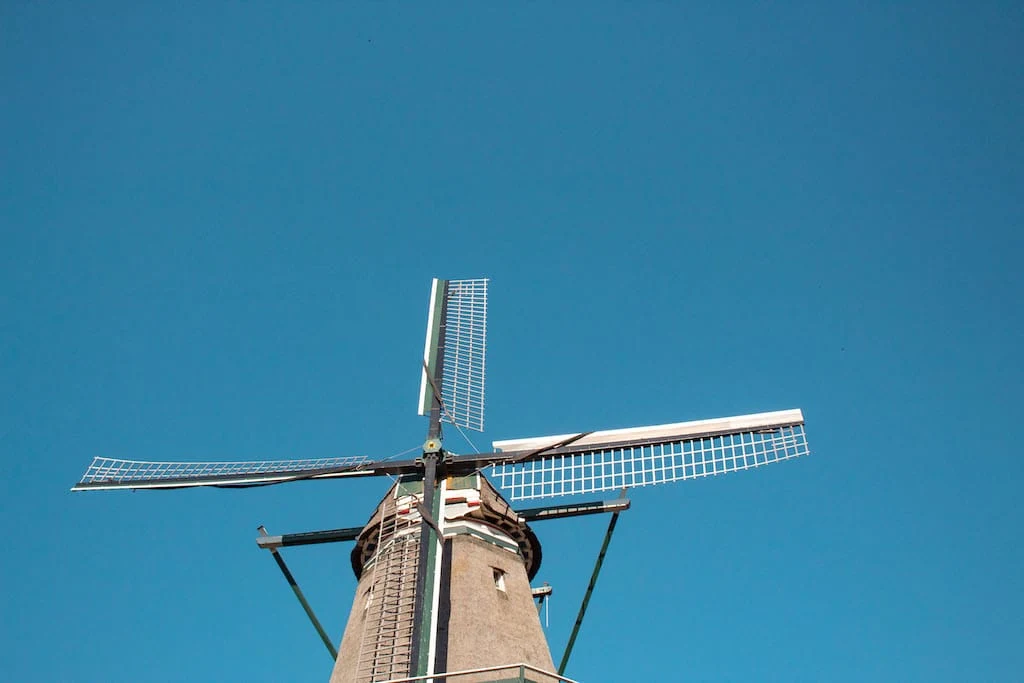
Deltawerken
The Delta works (Deltawerken in Dutch) are a defensive system for protection against high water from the sea. It consists of five storm flood barriers, three locks, and six dams. These can be found in the southwest of The Netherlands, in the provinces Zeeland, Zuid-Holland, and Noord-Brabant.
Watersnoodramp 1953 (North Sea Flood of 1953) is imprinted in everybody’s mind in The Netherlands. Historically, extensive flooding in the Netherlands (the southwest) is caused by a combination of high spring tide and a storm tide. In this flood, 1836 people lost their lives and were the impetus for building the extensive Delta works.
The Delta works consist of 14 parts and were built over a number of decades. Starting in 1954 with the building of the storm surge barrier Hollandse Ijssel and being completed in 1997 with the Maeslantkering.
The Oosterscheldekering and the Maeslantkering are the two that are visited the most, internationally speaking. The Delta works are what placed The Netherlands on top of the list in water management. In the world of civil engineering, it’s even called one of the seven modern world wonders.
The Maeslantkering consists of 2 large arms that can close off the Nieuwe Waterweg (New Waterway) together. Both arms are 237 meters in length. This way, the area around Rotterdam is protected against high water. The Maeslantkering can be visited from the side of Hoek van Holland. This is a 30-minute drive from Rotterdam.
The largest storm flood barrier in the world is the Oosterscheldekering, which was finished in 1986 and measures 8 kilometers in length. There are 65 pillars with 62 sliding doors in between. With a hydraulic system, the Oosterschelde can be closed off in 75 minutes. There’s a road over the Oosterscheldekering, which you can drive or bike. The barrier can also be seen from the water with a boat tour. Deltapark Neeltje Jans provides the possibility to see it from up close and inside. The Deltapark is 1 hour and 15 minutes driving from Rotterdam.
You can make a Delta tour and drive, bike or walk all around the Delta works. A famous landmark of the Netherlands, if nothing else, you’ll be in awe of the sheer scale of what the clever Dutch have achieved with this modern marvel.
Explored by Cosette from KarsTravels.
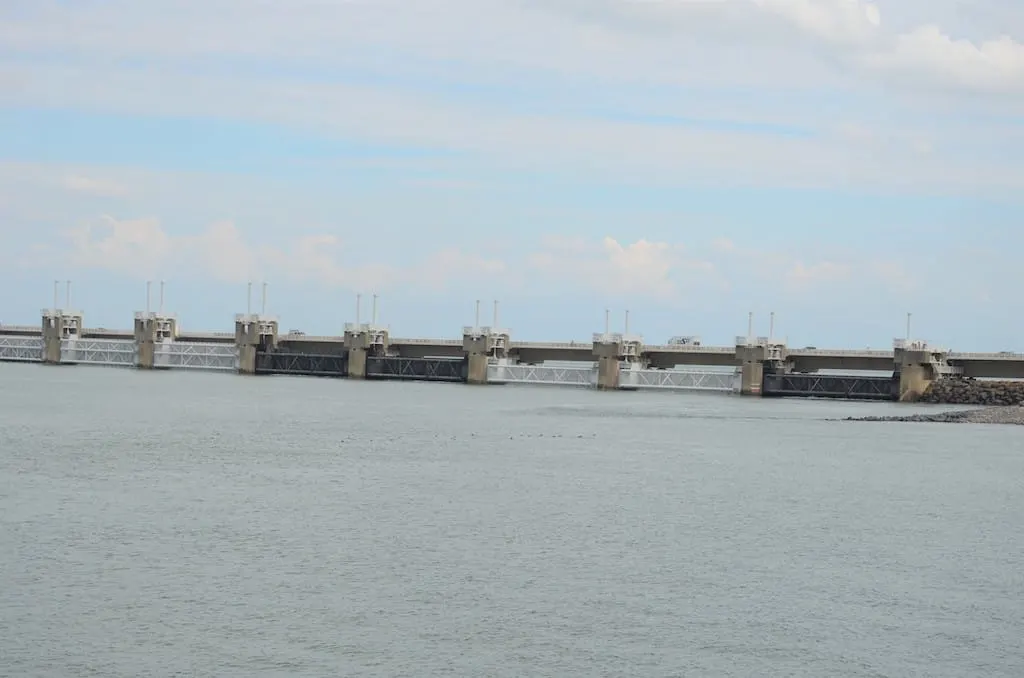
Dom Tower
The Dom Tower is located in the beautiful city of Utrecht. The 112-meter-tall tower is the tallest church tower in the Netherlands and a city icon that can be seen from afar. It’s a beautiful building dating back to the year 1321, and it has been wonderfully preserved. The best thing about the Dom Tower? You can climb its 465 steps to go to the top of the Tower and enjoy a marvelous view of the city and its surroundings. On a clear day, you can even see the cities of Amsterdam and Rotterdam!
The Dom Tower can only be visited as part of a tour; tours start every 30 minutes at the Tourist Center located across the Dom Tower. During the tour, a knowledgeable guide will tell you all about the Tower and its interesting history.
During your climb to the top, you will come across the beautiful stained glass in Egmonds Chapel, a huge bell called Salvator (it weighs 8200 kilos!) and drawings that show what the Dom looked like in 1580 and in 1674.
A ticket for the Dom Tower costs €10 for an adult and €5 for children between 4 and 12. Please note that you are not allowed to take bags with you during the tour, you can store your bag in one of the free lockers at the Tourist Center. From Utrecht Central station, it’s only about 10-15 minutes’ walk to the Dom Tower.
Explored by Lotte from Bestevoorkids.nl
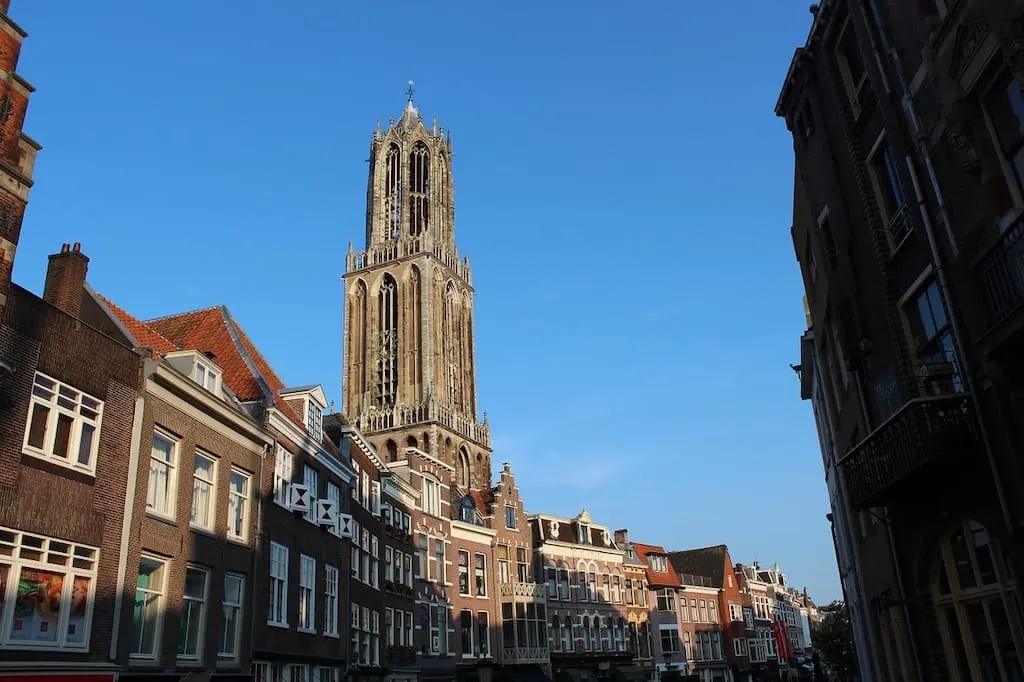
Efteling
If you’re looking for exhilarating rollercoasters, bewitching attractions and impressive shows, head out for a fun day at Efteling, the largest theme park in The Netherlands – and a Dutch landmark that we could visit time and time again.
A fantasy-themed amusement park located in Kaatsheuvel, the various attractions echo details from classical myths and legends, fairy tales, fables, and folklore. Efteling was opened back in 1952 and has since grown from a simple nature park with a playground and an (admittedly adorable) Fairytale Forest into a huge theme park with 5 million visitors annually.
Grab your day admission ticket and take a step inside a magical world full of astonishing tales, enchanting dreams, and adventures at high speed.
Visit the captivating world of fairies in the Droomvlucht dark ride then huddle together during the electrifying spectacular Raveleijn park show featuring stunt horse riders and a fire-breathing monster. End your day on a high at Aquanura, the biggest water show in Europe.
There is also the opportunity to set sail on a raging sea aboard the cryptic ghost ship De Vliegende Hollander and to shoot straight down a deep mineshaft at 90 kilometers per hour in the dive coaster Baron 1898.
Often referred to as ‘better than Disneyworld,’ Efteling is actually twice as large as the original Disneyland park in California and was built three years before it. However, in Europe, Efteling is not nearly the oldest theme park with Vienna’s Prater Park and Tivoli Gardens in Copenhagen being more than a century older.
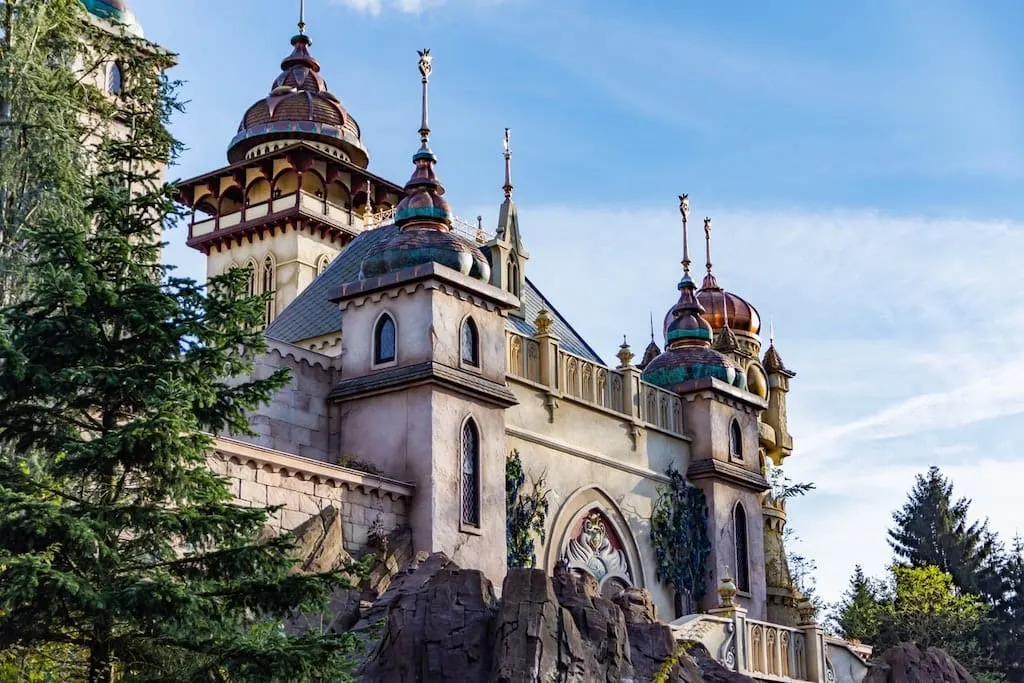
Erasmusbrug
The Erasmus Bridge, known as ‘Erasmusbrug’ in Dutch, is an iconic landmark in The Netherlands, located in Rotterdam. Because of its distinctive asymmetrical pylon shape, the Erasmusbrug has also been nicknamed as ‘The Swan’ by locals. The bridge has a span of 278 meters and is 802 meters long. On September 6th, 1996, the bridge was officially opened by Queen Beatrix after ten years of construction, which costs more than 165 million euros.
The Erasmusbrug connects the northern and southern parts of the city by spanning the Nieuwe Maas river and carries multiple vehicle lanes, tram tracks, bicycle lanes, and sidewalks. Watching daily life along the river is a fun thing to do in Rotterdam, especially around sunset, when the bridge is lit up by the soft sunlight colors. There are many benches along the quay where you can relax and watch lots of container ships and ferries passing by under the bridge.
What’s so cool and unique about the Erasmusbrug is that it’s both a cable-stayed bridge and drawbridge (bascule) in one. The bascule section allows safe passage for ships that are too large to pass under it. Another fun fact is that the Erasmusbrug is the biggest and heaviest of its kind in all of Western Europe.
The bridge was the setting for a few famous events such as the Jackie Chan film ‘Who Am I’ in 1998. In 2005 several small airplanes flew underneath the bridge as part of the Red Bull Air Race. The Erasmusbrug is also home to the annual National Firework show during New Year’s Eve and is part of the World Port Days in Rotterdam.
Located just a little outside of Rotterdam’s city center, you can easily walk to and over the bridge. A few nice restaurants with beautiful views on the Erasmusbrug are ‘Dudok aan de Maas’ and Hotel and Restaurant New York.
Explored by Ilse from Digital Travel Couple
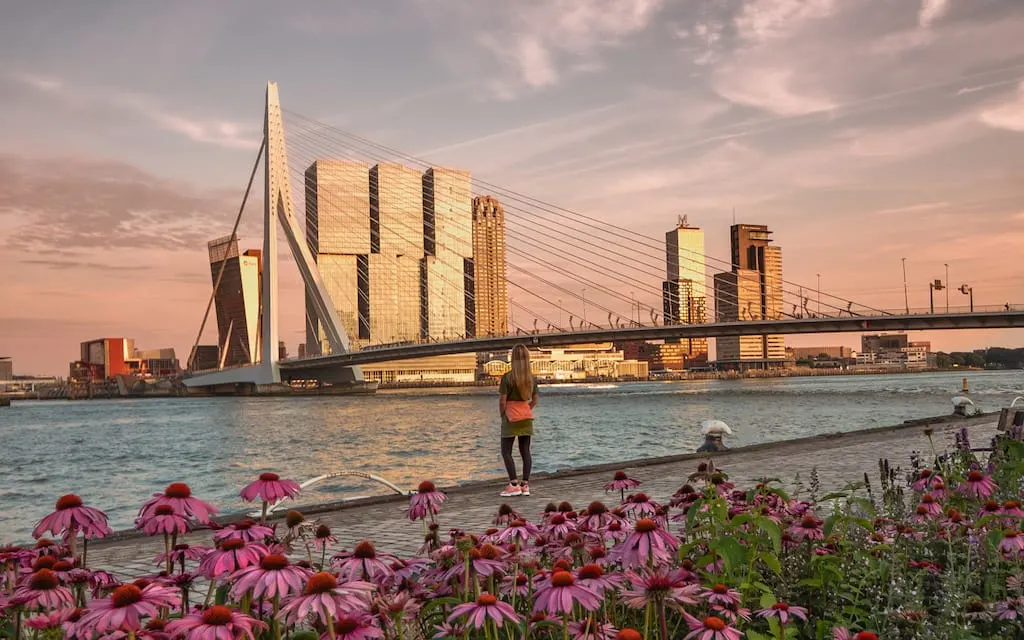
Evoluon
If you are planning a visit to Eindhoven in the Netherlands, it would be hard to miss this bizarre landmark of the Netherlands that is found here.
The Evoluon is a UFO-shaped structure that was commissioned by Philips in the 1960s. The 77-meter concrete dome was originally used as a science museum but now primarily hosts conferences, events, and meetings. It’s the closest Eindhoven has to a symbolic landmark and is a fascinating building even if you’re not that into architecture (or UFOs!).
In the 60s and 70s, the Evoluon captivated crowds of visitors, since its interactive exhibits were a fresh and unparalleled concept in the Netherlands at that time. However, in a world today filled with city’s that rise out of the sand like Doha and places like Gardens By The Bay in Singapore, the Evoluon is no longer as … interesting, to most people, at least. Still, we think it is worth a visit – and ‘out of this world.’
You can go and look around inside the Evoluon, although from indoors, it seems like your average conference center. It’s outside where you’ll get the impact, whether you’re seeing it by day when you can walk around the lake at the back, or at night when the Evoluon is all lit up and looking especially extra-terrestrial.
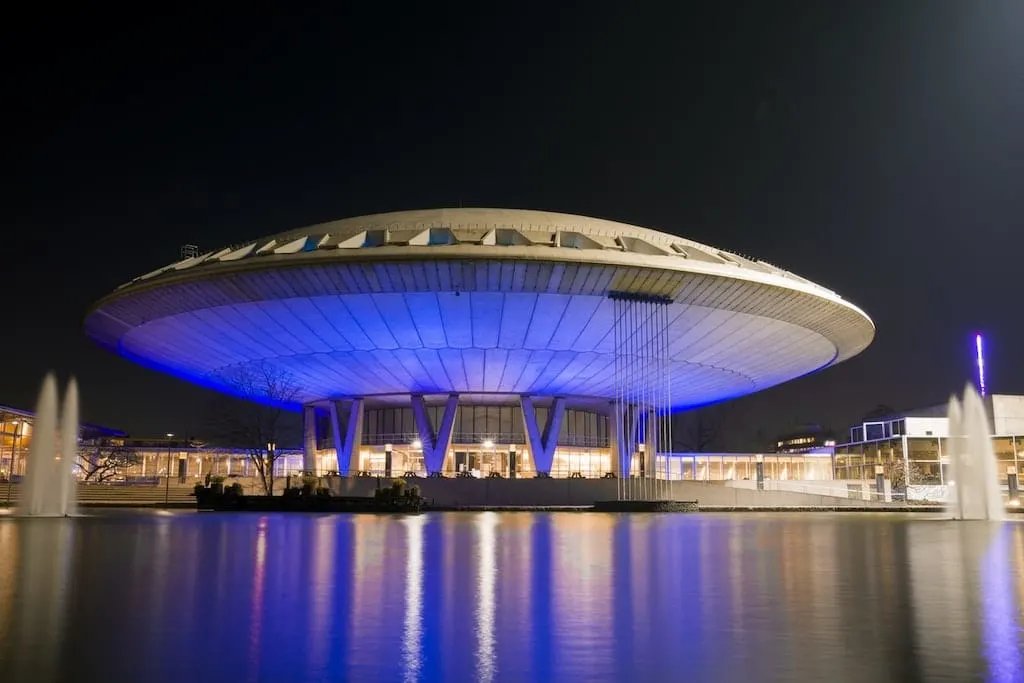
Gouda Cheese Market
If you’re visiting The Netherlands between the beginning of April and the end of August, you’re in luck, because then you can visit the traditional Gouda cheese market.
If you’re into cheese, and Gouda cheese, in particular, the cheese market is a must-visit during your stay in The Netherlands. And it’s easy enough to get to Gouda, which is situated in the heart of The Netherlands, not too far from Utrecht, The Hague, and Rotterdam. You simply take a direct train from Amsterdam, and it’ll take you to the beautiful medieval city of Gouda.
Traditionally, the cheese market is held on the market square in front of the stunning medieval city hall of Gouda. The market exists since 1395 and is one of the oldest cheese markets in The Netherlands. At the time, the region around Gouda dairy farming was the main source of income, as the peat-rich soil is very limited, which left the farmers no other option but to go into dairy. As there were so many dairy farmers, competition between farmers to make the best cheese was quite fierce, resulting in Gouda cheese being of excellent quality.
On Thursday mornings, the market rituals are performed in the same way as all these centuries ago. Dozens of grand, impressive cheese wheels are delivered to the market square by horse and carriage and stacked on the ground by farmers. From that point, they are traded in a traditional way.
It’s such fun to watch the cheesemakers and vendors haggling over the cheese wheels and sealing the deal they’ve made with a theatrical hand clap. To make things interesting for the tons of visitors who come to watch the spectacle, a lot of the cheese farmers and their helpers are dressed in original, local costumes and are more than willing to have their photo taken with you.
After a visit, pop into the Waag (weighing house). A beautiful historic building, from the Dutch Golden Age, where cheeses were weighed before being marketed. On the ground floor, you can taste and buy several Gouda cheese, while the top floors house the Gouda cheese museum, which will teach you everything there is to know about Gouda cheese.
Explored by Esther de Beer from Your Dutch Guide
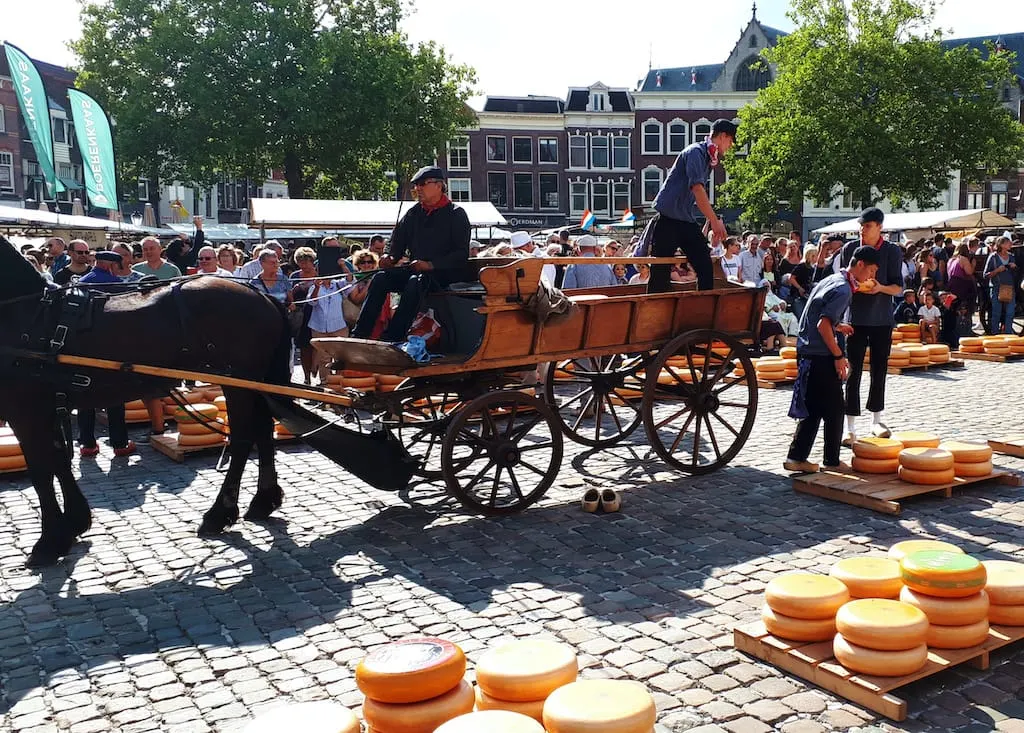
Keukenhof
Tulips are an icon of The Netherlands, and if you are in the country during spring, you should not miss the riot of colors that are the flower fields and gardens. Walking through the colorful gardens, breathing in the perfumed air, and taking in the beautiful delicate flowers is a bucket-list-worthy experience.
There are several places to enjoy Tulips in and around Amsterdam, and one of the best of those is the famous Keukenhof Gardens.
Spread over 70+ acres, the Keukenhof Gardens are located in Lisse. These Gardens feature more than 800 varieties of flowers and are (quite aptly!) named the Garden of Europe.
Though Keukenhof opens for just a couple of months of the year during spring, it gets more than a million visitors! So, it is a fairly touristy and busy place. However, this is one touristy attraction that is totally worth a visit! Just keep in mind a few tips to make the best of your experience.
Make sure you are there soon as the Gardens open – buy your tickets online and take the first bus out/ drive and get there early. Buses run to Keukenhof from several places in The Netherlands, including Schiphol Airport, Amsterdam, and Haarlem. Even during weekends, which are busier, the early morning hours are wonderfully quiet, and you can really appreciate the beauty and the tranquility of the Gardens.
Some of the most beautiful areas of the Gardens (though honestly, every inch of it is spectacular!) are around the pond near the Wilhelmina pavilion and around the windmill. Rows upon rows of flowers bursting with color and beautiful landscaping around them make the place superbly breathtaking.
Keukenhof Gardens are so much better than you would imagine, and pictures do not do justice to the place at all! It’s an absolute must-visit during your visit to The Netherlands.
Explored by Smita from My Faulty Compass
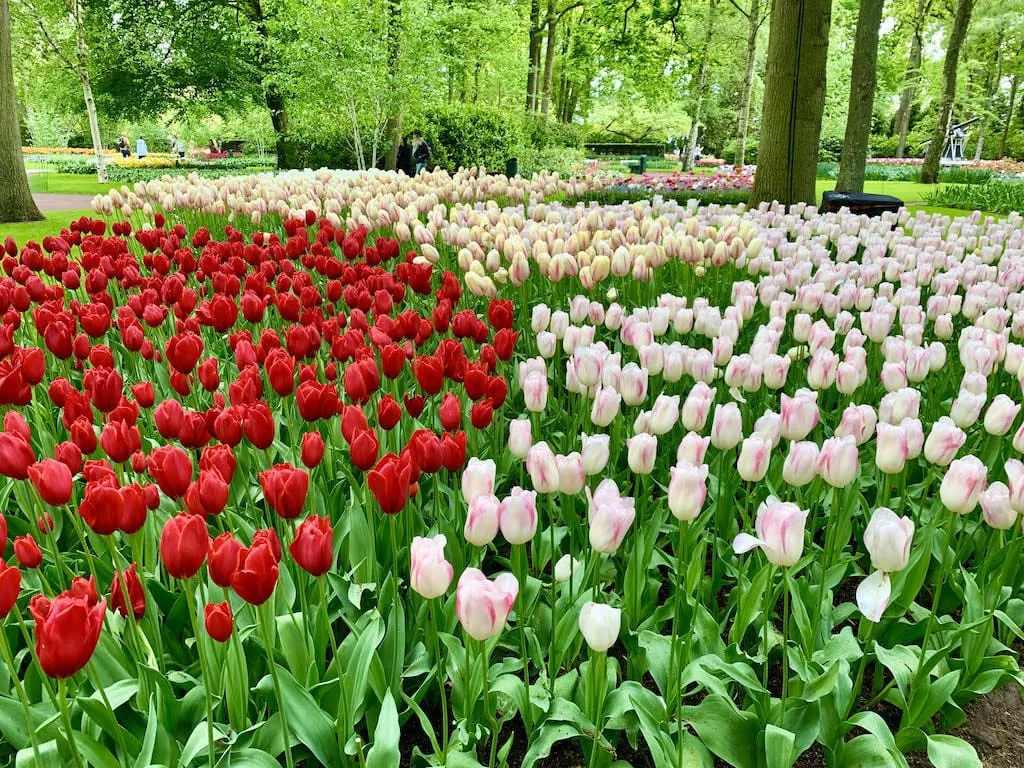
Kinderdijk
The windmills of Kinderdijk are one of the most popular Dutch tourist attractions and are a UNESCO World Heritage site. A visit to Kinderdijk is one of the best ways to understand the functionality and purpose of windmills, and will leave you with a great appreciation of the ‘water management’ which the Dutch have perfected over the past centuries! Kinderdijk is the largest concentration of old windmills in the Netherlands, consisting of 19 windmills, of which 14 are still inhabited, and you are able to visit three inside.
The name Kinderdijk is Dutch for ‘Children dyke’, which according to legend, was due to a baby which was found in a floating cradle after a notoriously devastating flood in 1421. The area (which is slightly east of Rotterdam) has been the site of a continuous battle against water, where the Dutch have struggled to get rid of excess water in the ‘polders’ (reclaimed lands). A series of 19 windmills were later constructed around 1740 to bridge the water level differences and pump the water into various reservoirs.
The Kinderdijk windmills are likely the most photogenic and most famous windmills in the country – situated in a postcard-like environment in a beautiful green scenery. The town of Kinderdijk is located just 15km of Rotterdam – you can reach it either by organized tour or otherwise by (rental) car. Recommended is to park in the town (just a few minutes’ walk) rather than the paid parking lot directly in front of the entrance.
You have the option of buying a ticket (± EUR 15) which allows you to enter three windmills, take a boat cruise along the canal (which drops you off at the windmill to visit), and to visit the (more modern) pumping station which has complemented the windmills’ capacity. Alternatively, you can enter the area (at no cost) and walk around the windmills, but you won’t be able to enter any.
Explored by Emma from Bonjour Sunset
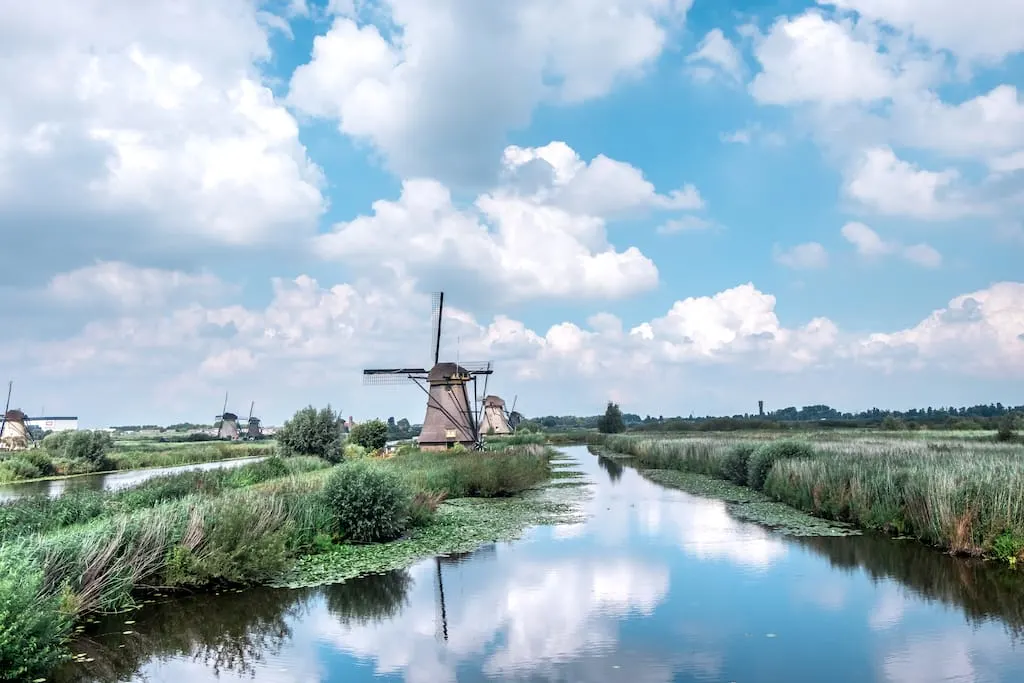
Kurhaus of Scheveningen
If you are looking for a fun getaway in the Netherlands or a cool day trip from Luxembourg, visiting the Kurhaus in Scheveningen is-a-must. Established in one of the famous landmarks in the Netherlands, The Kurhaus of Scheveningen, The Hague is a hotel, a.k.a. The Grand Hotel Amrâth Kurhaus, The Hague, since October 2014.
Built-in between 1884-1885 by the German architects, Johann Friedrich Henkenhaf and Friedrich Ebert, the hotel reflects the 1818 Italian Renaissance-style. The Kurhaus was preserved from demolition in 1975 by being registered as a historic building. Later on, it got restored entirely and then reopened in 1979 by Princess Beatrix. Though, the hotel has now become a significant part of tourist attraction in Scheveningen, Netherlands.
The Kurhaus hotel is even described as- ‘A world of luxury by the sea.’ That’s because the hotel operates 270 rooms, including nine-board-rooms, a restaurant, a terrace, and a spa, presenting a sea-view, which likewise makes it so ionic. Indeed, it’s an ideal place where tourists can entertain themselves by enduring the classic, comfort, and stylish-interior with waves’ soothing sound.
The hotel is located in Gevers Deynootplein 30, Scheveningen district, in the city, ‘The Hague,’ at the coastline of the Netherlands. Moreover, to reach Kurhaus of Scheveningen, travel by Bus, Train, or Light Rail. The lines and routes that stop nearby Gevers Deynootplein 30 are- Bus: 21, 22, 23; Train: SPRINTER; Light Rail: 1, 9. The train journey takes approximately 4h 42min for around 161 km. But another straightforward way is to catch a bus to reach the destination.
Some insider tips that’ll even excite you to visit there are that the hotel is a 3-minute walk from the beach, making it a perfect location to stay. Each room offers extra-long, comfortable-bedding, alongside a private-bathroom with contemporary décor. Free-of-cost Wi-Fi access is also available there. Besides that, the restaurant serves an extensive breakfast and classic French-style-haute-cuisine dinner, and highlight views over the North-Sea.
The Kurhaus Spa & Beauty additionally offers its guests various spa-facilities, upon prior reservation. It also holds an indoor-pool with a panorama of the beach. However, Scheveningen can be crowded, especially during the summer, so the best time to visit is May-June-September.
Explored by Paulina from Paulina On The Road
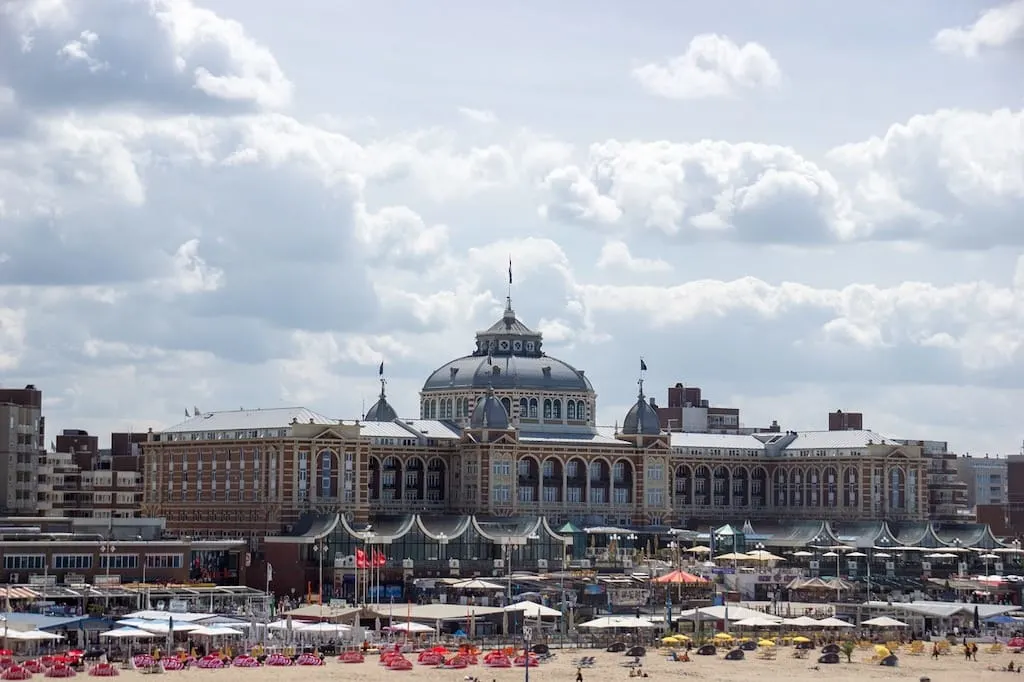
Madurodam
Imagine having a replica mini-country within a country but only 25 times smaller! No, this is not the storyline of a sequel to the movie “Inception.” This is about one of the most famous and unique landmarks in the Netherlands called Madurodam.
Located in the Scheveningen district of Hague, Madurodam is a park that has miniature model replicas of famous Netherlands attractions and cities. The models are made on a scale of 1:25, which means that everything you see in this park is 25 times smaller than the actual size of that landmark or attraction.
Basically, you get to feel like a dinosaur in this beautifully crafted world. And it’s this surrealism which makes Madurodam an iconic and one of the most popular tourist attractions in the country. Standing next to mini monuments, windmills, bridges, gardens, and even airports is an exhilarating and enjoyable feeling.
It’s a place that brings out the inner child of adults and turns children into crazier and more exciting beings. A special mention to the intricate detailing gone into making every component of the park – including the streets, trees, and people whose clothes change depending upon the season in which you’re visiting Madurodam.
Madurodam was built by Mrs. B. Boon-van der Starp in the memory of a Dutch war hero named George Maduro, who resiliently fought against the fascist Nazi forces in the Second World War. In fact, George’s parents had also donated funds to complete the Madurodam project.
In a way, the park’s a symbol of bravery and a tribute to the son of the land. S.J. Bouma, a famous architect, implemented the design of the park. The park acts as a first-hand interaction of a visitor with the history of the Netherlands as they see the phases of evolution of the country. The park has a cafe, souvenir shop, several food joints, restrooms, and a separate play area for kids.
Madurodam is open all seven days of the week from 9 AM – 6 PM. As for getting there, a smooth 45-minute drive by car or a shared coach from Amsterdam gets you to the park. The entrance fee per person is €17.5. Children aged two and below enter for free. There are also exclusive discounts for people in groups of four.
Explored by Vaibhav Mehta from The Wandering Vegetable
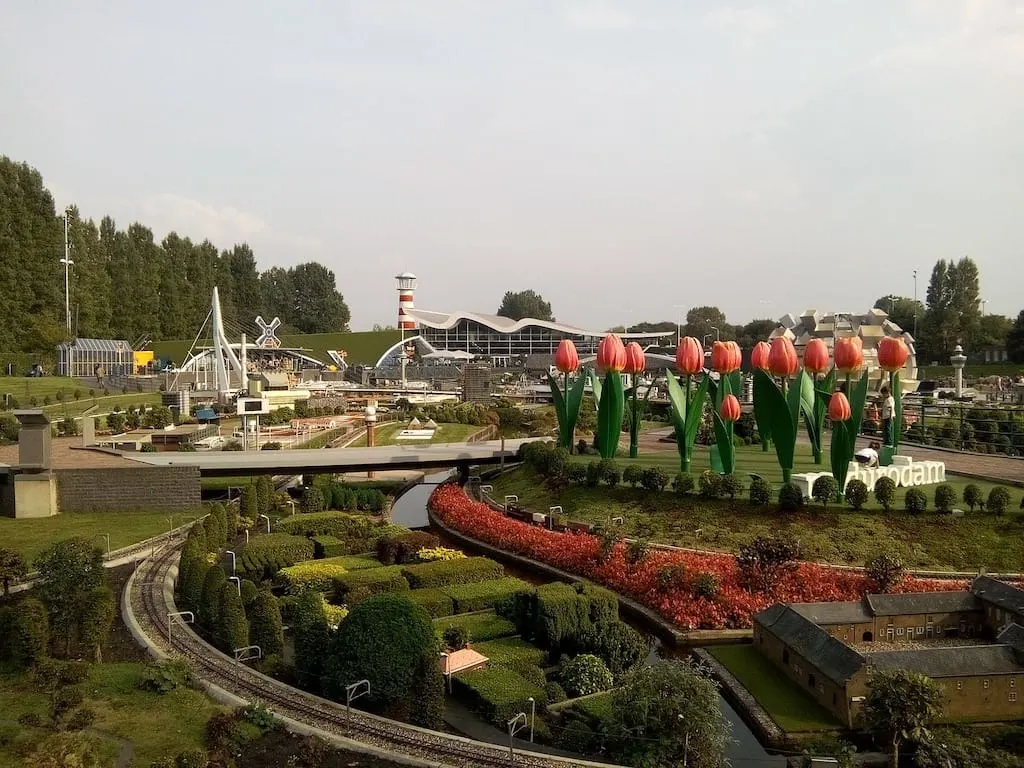
Rietveld Schröder House
The primary reason for my trip to Utrecht was to visit Rietveld Schröder house. Built in 1924 and been the private residence of the Schröder family till 1985, this building is a masterpiece and a fine example of the Dutch De Stijl Art Movement. This was designed by Gerrit Rietveld along with the owner of the house, Ms. Truus Schröder. True to the De Stijl movement, the design is minimal, with emphasis on vertical & horizontal lines, the use of primary colors, and a harmonious blend of interiors & exteriors.
Rietveld Schröder house has two floors. The ground floor primarily consists of the kitchen. Clever design ideas implemented on the ground floor include the use of the kitchen window’s shutters as food trays and the hidden staircase to reach the first floor, which can be opened with a lever. The first floor has the most fascinating feature of the entire house – sliding walls!
This entire space was used as one very large room in the day. But by night, the sliding walls were slid-out, and this space was segregated into four rooms providing enough privacy for all the three children of Ms. Schröder. The very famous red-blue chair, also designed by Rietveld, was just beside the window, which was Ms. Schröder’s favorite spot in the whole house from where she enjoyed the view of the polders in front (which don’t exist anymore!).
This is located about 3km from Utrecht Centraal but is connected very well by buses & trams. It is absolutely essential to prebook the tickets as early as possible as only a certain number of people are allowed in per day. On-the-spot tickets are almost never available.
Explored by Bhushavali of My Travelogue by Bhushavali
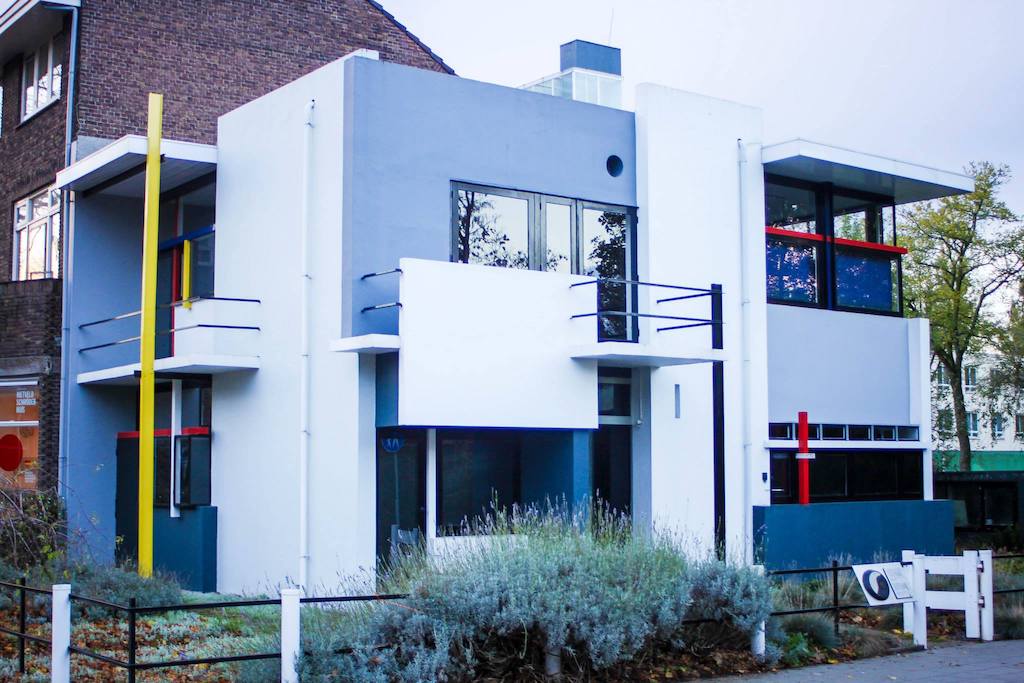
Stedelijk Museum Amsterdam
The Stedelijk Museum in Amsterdam is an international museum devoted to modern and contemporary art and design — and one of the famous modern landmarks of the Netherlands.
Located at the Museum Square in Amsterdam South, it is close to many of the other famous museums in Amsterdam, like the Van Gogh Museum, the Rijksmuseum, and the Concertgebouw. The Stedelijk Museum is actually composed of two buildings, a 19th-century building and (more famous) 21st-century wing, which is where the current entrance is (opened in 2012 at the cost of €127 million).
Much like the stunning National Museum of Modern Art in Tokyo and Museum of Contemporary Art Kiasma in Helsinki, the building is as impressive as the collection of art houses within, and no visit would be complete without appreciating both. Thankfully, The Stedelijk Museum has a world-class collection of modern and contemporary art and design from the early 20th century up to the 21st century. Inside you’ll find artists such as Vincent van Gogh, Jackson Pollock, Andy Warhol, and Lucio Fontana — along with many works you’ll never have heard of.
With major clusters and cores concentrating on De Stijl, Bauhaus, Pop Art, and CoBrA and, lately, Neo-Impressionism, the accumulation here renders virtually every meaningful movement in art and design of the 20th and 21st centuries. Plan at least half a day to make the most of this incredible place.
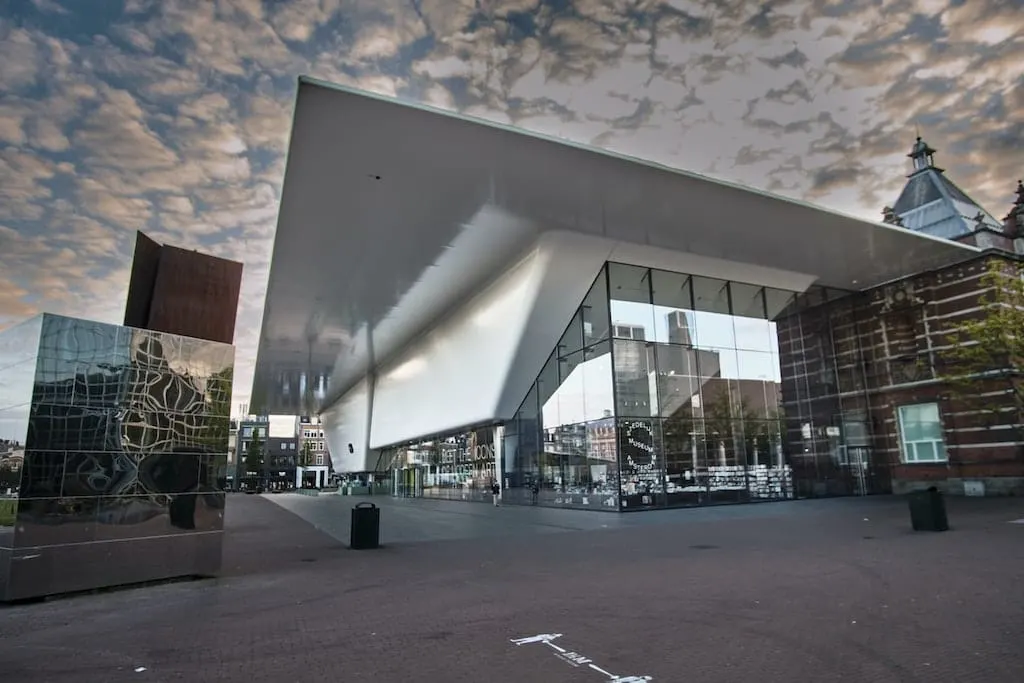
Texel Lighthouse
Located on the northern tip of Texel’s coastline, this famous Netherlands landmark is one of the Dutch island’s most popular sights and is a must-visit should you be lucky enough to spend some time on Texel one day.
Texel itself is an island located in the North Sea just off the coast of North Holland and can only be reached by the regular ferries that cross the short body of water there, departing from Den Helder.
The largest of the Netherlands’ Wadden Islands, Texel is a popular travel destination for the Dutch and other nationalities alike, and it’s not hard to see why thanks to miles of beautiful coastline and hectares of natural woodlands, farmland and sand dunes making it a true escape should you combine it with visiting Amsterdam or one of the other cities in the Netherlands.
A lighthouse has been standing in that spot since the 1860s, and it was much needed to prevent ships from crashing in the turbulent waters in the area. When visiting, you can climb up its 118 steps to enjoy beautiful views of the rest of the island and the neighboring uninhabited Vlieland island. You will also find out more about the island, more about the lighthouse’s history, as well as the role it played in the Second World War. On the walkway to and from Texel Lighthouse, you will also spot a number of bunkers from that time scattered around the dunes surrounding the lighthouse.
A quick and easy place to visit during a stay on Texel as there is a car park and a bus service running there regularly, the Texel Lighthouse is an opportunity to get to know the island better both in terms of its history and to enjoy some brilliant views of this unique part of Europe.
Explored by Frankie Thompson from As the Bird flies.

The 30-mile Beach Between Scheveningen and Zandvoort
As a Caribbean soul, I did not expect to fall in love with a Dutch beach on the mainland, but the amazing quality of the beach between Scheveningen and Zandvoort, two of the Netherlands’ main tourist destinations on the sea, changed my mind.
The beach, which is located between Amsterdam and Rotterdam, has an impressive uninterrupted length of 28 miles, meaning you could walk for around 10 hours without your feet leaving the sand. If you take a little 1.5-mile detour around the small harbor of Scheveningen, the beach is even 10 miles longer and ends at the western tip of the Rotterdam Harbor, the biggest port in Europe.
It’s not only the length that sets the beach between Scheveningen and Zandvoort apart, but it’s also the quality of finest sand and the width of the beach, which can easily be more than 200 yards. Furthermore, the beach is flanked by an impressive dune landscape, which is also accessible by several hiking and cycling trails. Hence if you want to go all the way from Zandvoort to Scheveningen, consider renting a bike.
If you don’t want to hike nor cycle, you can enjoy the area in one of the towns along the beach: Zandvoort, Noordwijk, Katwijk, and Scheveningen. Although the architecture of these villages is not the most attractive, they offer plenty of beachside cafés and restaurants along the oceanfront promenade and are perfect for enjoying the European sun in the summer. Of course, you can also have a swim in the ocean, which is a very family-friendly option as it is a gently sloping beach.
Zandvoort, Noordwijk, and Scheveningen can be best reached with your rental car as public transport options connect via Harlem and Den Haag and are therefore time-consuming.
If you want to visit and stay along the beach during the summer months (June to August), make sure to prebook your accommodation well in advance as the area is widely popular among Dutch and German travelers and highly frequented in peak season.
Explored by Chris from Punta Cana Travel Blog
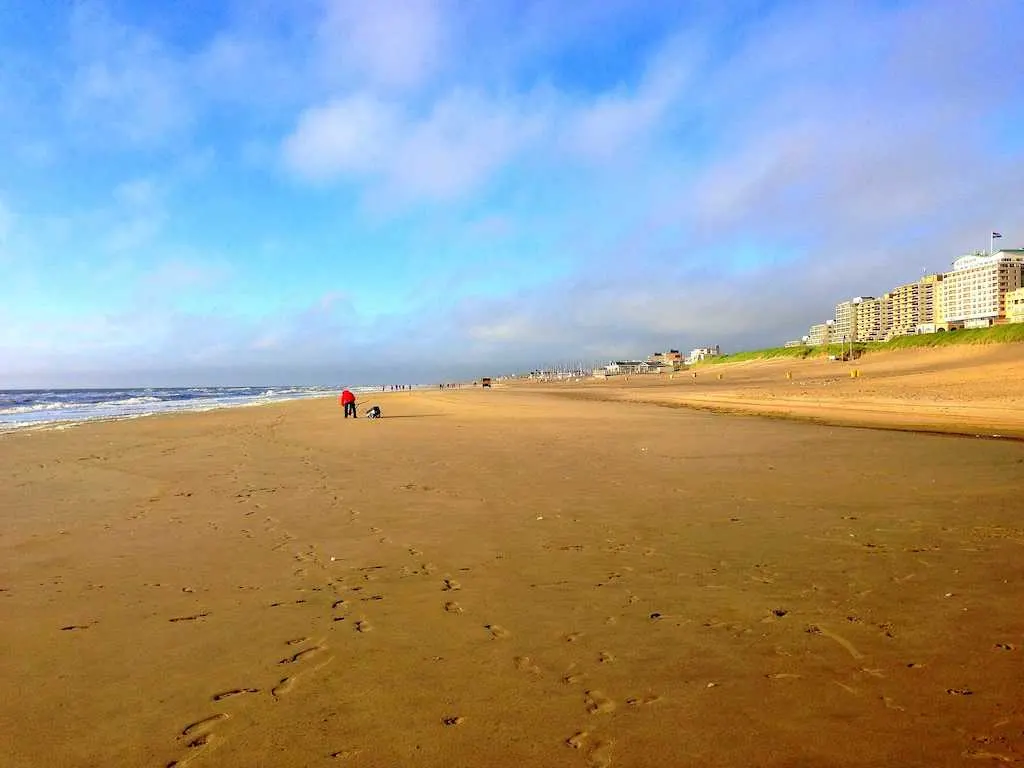
The Canals Of Amsterdam
The canals of Amsterdam have to be one of the most iconic postcards of Europe. They encapsulate the city, are intertwined with the buildings, and they are around just about every corner of Amsterdam. It would be hard to miss this famous landmark of the Netherlands if you tried, and no trip to Amsterdam is complete without seeing the sites from the water.
There are so many options from audio tours on larger canal vessels, to eco self-guided electric boats.
Not only will you get to see many different neighborhoods as you float by, you’ll also get to see incredible boat houses and discover a very Dutch way of living.
If you choose to use Eco Boats Amsterdam, they will give you a map, sailor hats, and comfy cushions for the journey. It was really easy to navigate independently, and bringing a picnic for the afternoon was such a nice touch that you wouldn’t get on the larger vessels. The eco boat was a great option with kids.
Of course, there are lovely trips that are more romantic with candlelit dinner trips on the canal. This is another unforgettably special experience on the canal.
Depending on the route you choose for your trip around the canals of Amsterdam, you might get to see sites such as the Anne Frank House Museum, The Red-Light District, and the Heineken factory. With over 100km of waterways to discover, you can really see just about any site in Amsterdam from the canal.
It can be chilly on the waterways, especially when you go under the narrow iconic bridges of the city, so make sure to bring a jumper!
Explored by Karen from Travel Mad Mum
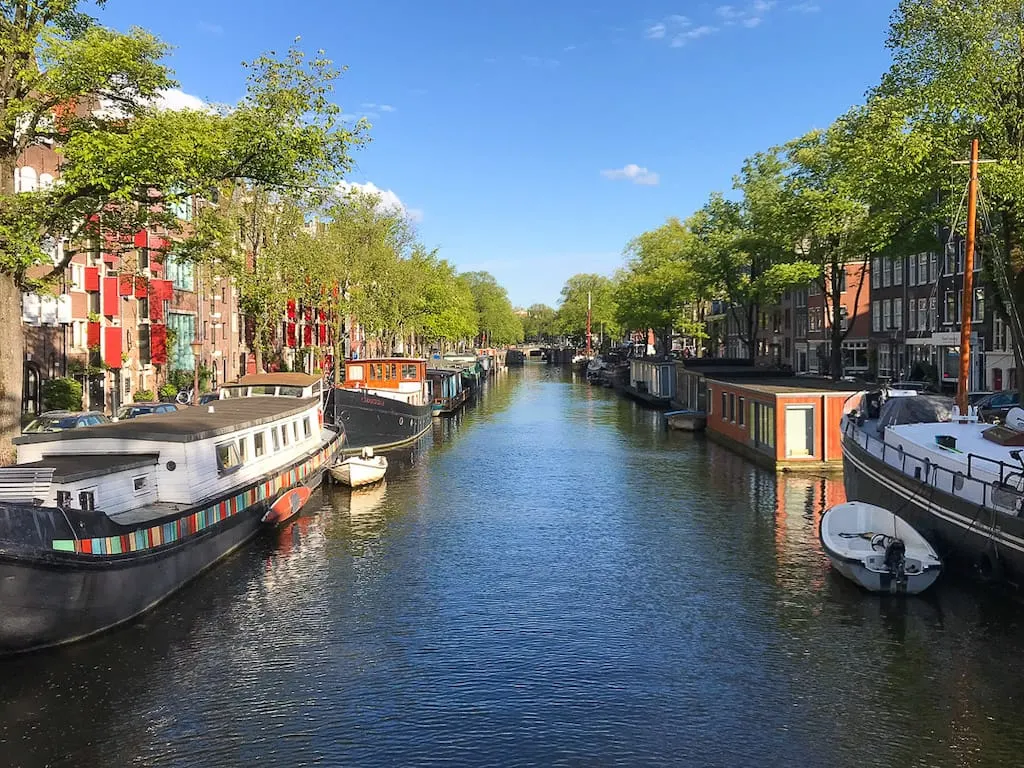
The Gingerbread Houses on Damrak
Although Amsterdam is famous for its colorful canal houses dotted all over the city center, the most iconic buildings in Amsterdam would have to be the ‘gingerbread houses’ located on Damrak. They are the subject of many Instagram photos, and it’s not hard to see why. They really do look like they are made out of gingerbread, straight out of a fairy-tale story!
The reason why some of the Gingerbread houses are slanted is due to the way in which they were built. Because of the swampy nature of the canals, the houses actually sit on wooden piles, which are drilled meters deep into the mud. This is so that the houses don’t sink into the canals. However, some of the older structures are starting to sink unevenly, making them appear skewed.
To get the gingerbread houses is very easy. They are located on Damrak, which is only a short walk down from Central Station, on the left as you head towards Dam Square. As you walk out of the station, look for the spot where the canal boat tours depart, and you’ll see the gingerbread houses rise up from of the canal. Alternatively, you can also get a side view of the houses from Damrak Bridge (along Prins Hendrikkade). You could also do a canal tour and see the gingerbread houses close up!
Don’t be fooled by the serenity of the photos on Instagram. The area is very close to Dam Square and can get very busy with tourists later in the day, so the best time to wander past and snap some photos of these cute houses is early in the morning. The water will also be fairly still then so you’ll get some great reflections of the houses from the water. Alternatively, during sunset, there is a beautiful light shining on the houses.
Explored by Amanda from Bucket List Seekers
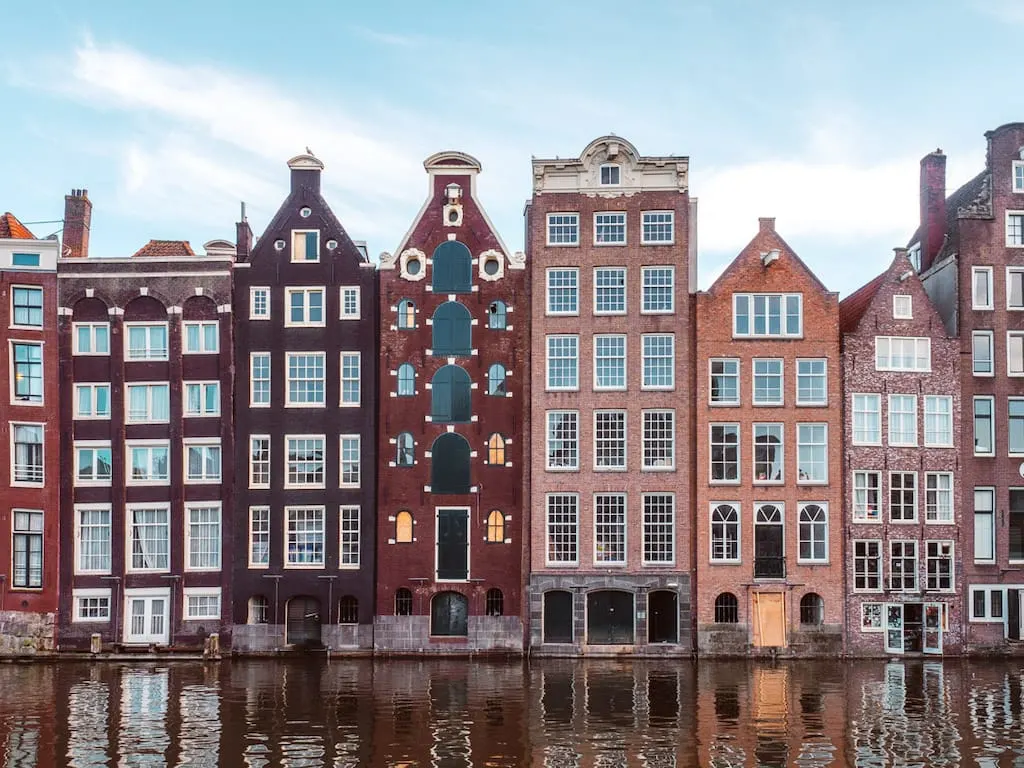
Vaalserberg
The name of the Netherlands translates in English as the Low Lands, and indeed the country is as flat as a pancake. One-third of it lies below sea level.
So, if there happens to be just the smallest bump that resembles a hill, it’s a big deal. What can be more iconic in the Netherlands than a proper mountain? Vaalserberg, with its 322.40 m, is the highest point in the country. It crowns up the hilly region of South Limburg and stands at the point where the three countries: Germany, Belgium, and the Netherlands, meet their borders.
Vaalserberg, with the Three-country point (Drielandenpunt), is one of the most famous Dutch landmarks and a popular tourist attraction. At the top of the hill, there are two viewing towers – one is on Dutch soil (the Wilhelmina Tower, 35 m high), and the other one – the Bodewijn Tower, 33 m high, is in Belgium. Climbing them rewards you with a stunning view of the three countries.
At the point where the three borders meet, there is a boundary stone with flags, a favorite place to take a picture of being at the same time in three countries.
There’s also a gigantic maze, which is quite fun to solve, and a few cafés, where you can get a bite and have some refreshments.
Vaalserberg and the Three-country point (Drielandenpunt) can be easily reached from Maastricht (30 km) in the Netherlands and Aachen (5 km) in Germany. There are good bus connections from both cities to Vaals, the town that’s located at the foot of the hill. Once in Vaals, you can either choose to walk to the top, which takes about 40 minutes or take the bus (line 159).
Explored by Daniela from Exploring the Netherlands

Van Gogh Museum
Among Amsterdam’s more modern of buildings, the Van Gogh Museum holds a special place. Located in the famous Museum Square in Amsterdam in the distinct company of Stedelijk Museum and the Rijksmuseum, the Van Gogh Museum is still beautifully surrounded by green areas where the youths of the city like to hang out and enjoy a drink or a picnic. It’s here that you can take in the particular vibe of this place, especially if you visit Amsterdam in spring.
Open in 1973; the museum hosts the world’s largest collection of Van Gogh works in the world.
It consists of two buildings: the Rietveld building and the Kurokawa wing. The former is home to the permanent location with an introductory exhibition, a café, and a shop on the ground floor. The first-floor deals with the works of Van Gogh in chronological order, while the second floor focuses on the work done for the restoration of paintings. The highest floor addresses works by the artist’s contemporaries. The Kurokawa wing is where temporary exhibitions take place.
The museum is open daily from 9 AM to 6 PM and can be easily reached by public transport from anywhere in the city. The nearest public transport stops are Van Baerlestraat (tram 2, 5 or 12) or Museumplein (tram: 3, 5 or 12, bus: 347 or 357). Due to a limited number of access tickets, they can only be purchased online for 19 euros. Visitors under 18 get free admission, while students get a discounted ticket for 10 euros.
Explored by Anca, from Dream, Book, and Travel
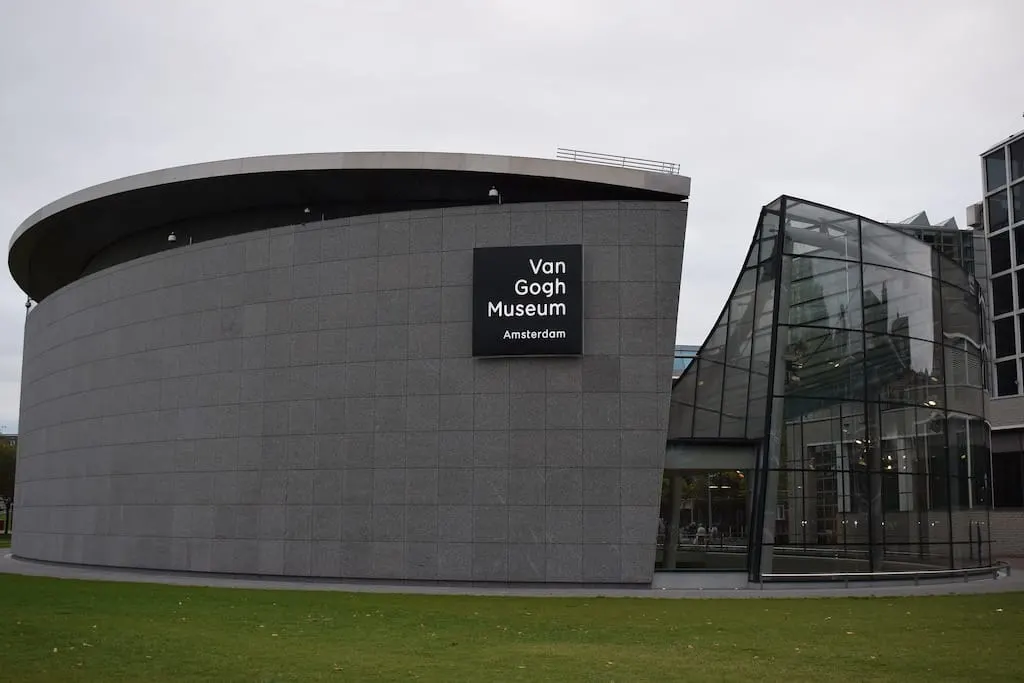
Van Nelle Factory
In the 1920s, the paradigm-shifting Van Nellefabriek was planned and constructed on the banks of a canal in the industrial region of Spaanse Polder, northwest of Rotterdam.
The project today stands as a shining landmark of modern architecture of the 20th century, containing a cluster of factories, with facades composed mostly of steel and glass, making extensive use of the ‘curtain wall’ concept — something that had never been done before. It was conceived as an ‘ideal factory,’ accessible to the outside world, where internal workspaces formed as required, and where sunshine was used to provide good working conditions.
Before this innovation, factories were dark and often horrid places, and you can see the influence of this building type in all the modern skyscrapers of today.
It represented a new type of factory that would become a hallmark of the inter-war modernist and functionalist era and provides witness to the Netherlands’ long entrepreneurial and manufacturing tradition in the field of importing and exporting food goods from tropical countries and their agricultural production for selling in Europe. The Van Nelle Factory is one of the world’s few industrial heritage UNESCO sites, like the Fagus Factory in Germany and Blaenavon Industrial Landscape in the United Kingdom, and a prime example of the International Style based upon constructivist architecture.
Today, it is considered one of the most beautiful factories in the world, although it is no longer used as such. The complex was renovated and reimagined in the early 2000’s – though the architectural elements for which it is renowned for are protected. Now it houses a wide range of media and design firms, and devotees of architecture, art, and industrial heritage can enjoy the onsite museum.
There is car parking on-site, but for most travelers, the easiest way to get to the Van Nelle Factory is by taking bus 38 from Rotterdam Central Station.

Windmill De Adriaan
Fifteen minutes journey by train from Amsterdam in the lovely city of Haarlem and one of its iconic things to see is the De Adriaan Windmill.
Sitting on the River Spaarne, the Molen de Adriaan has been through several incarnations. Built in 1778 on the foundations on the 16th Century defense towers.
The windmill first ground seashells and oak bark and tufa, a type of limestone used in cement. In 1802 the windmill was sold and started milling tobacco to make snuff for the gentry.
1865 saw a change of use again when a steam engine as installed, and the windmill started grinding corn. By 1925, it had fallen into disuse and was acquired by the Dutch Windmill Society to stop the iconic windmill from being demolished.
A devastating fire broke out in 1932, and the windmill burnt to the ground, much to the shock of the Haarlem townspeople. The people of Haarlem started to raise the money to rebuild the windmill. Finally, in 1999, they raised the 2.5 million Guilder to rebuild it.
It finally reopened in 2002 as a museum. The windmill is still capable of milling corn, but it is normally only done for tourists on Sundays and holidays, but check with the museum to confirm.
There is a 45-minute guided tour of the museum covering the history and exhibitions of the workings of the windmill. Depending on the weather, the tour also allows you to stand on the viewing platform 12 meters up, which gives you a 360-degree view over the city.
The windmill has 75 stairs to climb, some of them quite steep, so, unfortunately, it is not suitable for less-able visitors.
On the ground floor, you can get refreshments and buy souvenirs either before or after the tour.
Explored by Larch from The Silver Nomad




